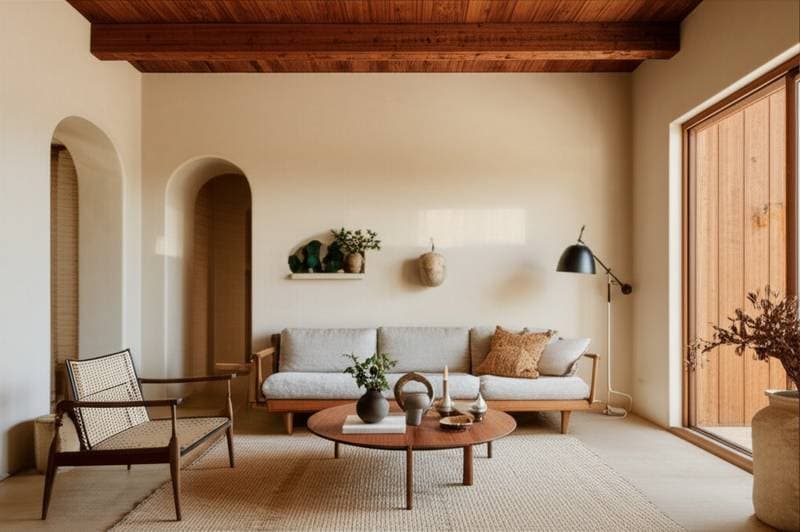Why Wabi-Sabi's Imperfect Homes Define 2025 Trends
Homeowners often enter spaces that evoke immediate tranquility, despite visible imperfections such as subtle wall cracks or eclectic furniture arrangements. This sense of quiet completeness embodies Wabi-Sabi, a Japanese philosophy that honors imperfection and genuine expression. In 2025, this approach influences home construction, renovations, and daily living as individuals prioritize environments that resonate on a personal level.
The Appeal of Imperfection
Contemporary design frequently favors sleek surfaces and impeccable upkeep, yet many seek alternatives that avoid such rigidity. Wabi-Sabi emphasizes organic elements like pronounced wood grains, irregular plaster applications, and artisanal ceramics, each bearing traces of their creation process. This philosophy aligns with a broader yearning for residences that evolve organically, mirroring the rhythms of everyday existence.
Sterile aesthetics demand ongoing effort to sustain their appearance, which can lead to unnecessary stress. Wabi-Sabi counters this by promoting acceptance of minor irregularities, fostering interiors that mature elegantly and capture the essence of their inhabitants' experiences.
What Wabi-Sabi Looks Like at Home
Wabi-Sabi interiors avoid disorder while cultivating equilibrium, restraint, and individuality. Practitioners select organic substances such as timber, earthenware, flax fabrics, and rock formations. Surfaces adopt a subdued sheen, and hues draw from the earth in tones of gentle slate, subdued foliage greens, and inviting earth shades.
Key features encompass:
- Unfinished timber flooring that reveals natural patterns and patina
- Earthen or hydraulic lime plaster surfaces offering tactile variation
- Bespoke fittings crafted by regional makers
- Antique or recycled furnishings infused with provenance
- Unobstructed floor plans that facilitate natural illumination and circulation
Each element serves a function and narrates a history. A vessel with a minor chip remains in rotation for its utility and charm. An artisanal tile with slight variance enhances visual interest rather than detracting from it. Such choices yield dwellings that exude sincerity and warmth.
Bringing Wabi-Sabi to Your Space
To integrate Wabi-Sabi principles, emphasize genuineness over superficial trends. This style emerges from intentional selections that align with personal narratives, not from assembled kits.
-
Initiate with simplification. Eliminate possessions lacking utility or significance. Ample void space elevates the value of retained items.
-
Opt for organic substances. Exchange fabricated or artificial coatings for timber, mineral, or flax. These endure gracefully through years of use.
-
Incorporate tactile elements. Coarse plaster, interlaced fibers, and untreated lumber impart coziness independent of ornamentation.
-
Select subdued palettes. Employ terrestrial shades such as sand, clay brown, and pale ash. These foster serenity and harmonize with ambient glow.
-
Blend eras. Pair contemporary forms with inherited pieces or salvaged treasures. The juxtaposition accentuates maturity and skill.
-
Permit natural variances. Refrain from immediate restoration of every blemish or discoloration. Subtle marks infuse character into the environment.
Cost and Practical Considerations
Expenses for Wabi-Sabi adaptations fluctuate based on scope and selections. Basic enhancements, including application of mineral-based coatings, substitution of fabricated textiles, and integration of artisanal accents, typically range from $1,000 to $5,000. Extensive modifications, such as laying broad timber planks, resurfacing with plaster, or updating storage with organic veneers, might total $20,000 to $50,000, influenced by residence scale and material origins.
This methodology often proves more economical than polished contemporary schemes. Resources direct toward durable artistry and endurance rather than fleeting flawlessness. Procuring regional or recovered components lowers outlays and advances eco-conscious construction.
Timeline:
Modest alterations conclude in several weeks. Comprehensive overhauls addressing substrates, enclosures, and fixtures span months. Hand-applied processes extend durations relative to industrialized outputs.
Difficulty:
Accessible tasks for self-directed efforts involve coating, abrading, and adorning with organic weaves. Specialized applications like plastering, framework adjustments, or wiring necessitate expert involvement. Authentic plaster methods blend lime and aggregate, demanding proficiency for secure and uniform results.
Safety:
Utilize safeguards during abrasion of legacy layers or manipulation of salvaged timber. Verify absence of hazardous residues like lead coatings or fibrous insulators in reused items. Seek guidance from certified specialists when uncertainties arise.
Why Homeowners Are Choosing Wabi-Sabi
This paradigm resonates with demands for eco-friendly, individualized aesthetics. Residents desire authentic havens over curated displays. Wabi-Sabi advocates mending over discarding, valuing substances that develop patina organically. It supports psychological equilibrium by crafting serene, flawed, and intimate settings that alleviate tension and encourage presence.
Design professionals note its compatibility with diverse aesthetics, including Nordic spareness, agrarian simplicity, and urban grit. Success hinges on moderation. Maintain clear expanses to allow form, radiance, and execution to convey essence.
Regional Differences and Building Codes
In moisture-rich or seaside locales, permeable plasters and timber exteriors require vigilant protection. Select vapor-transmissive barriers that safeguard without sealing. Arid zones permit untreated lumber and clay features to persist for generations with sparse intervention.
Review municipal regulations prior to alterations affecting structure. Certain organic coatings, such as soil-based plasters, mandate designated damp-proofing or airflow systems. Engage qualified builders to uphold standards while preserving stylistic purity.
Long-Term Value and ROI
Wabi-Sabi transcends ephemeral vogues through enduring allure. Structures employing robust organics demand infrequent renewals. Market dynamics influence resale premiums, yet discerning purchasers favor genuineness and superior workmanship. Thoughtful implementations elevate desirability via instilled harmony and perpetuity.
Living with Wabi-Sabi Design
Sustain equilibrium through periodic care:
- Reapply permeable mineral coatings to enclosures as required
- Administer annual oil treatments to timber for sustained luster
- Alternate position of crafted weaves or floor coverings to even usage
- Steer clear of chemical agents that erode organic compositions
Initiate Your Wabi-Sabi Transformation
Commence modestly by targeting a single area or nook for refinement and tempering. Substitute a factory item with an artisanal counterpart, or dismantle dense embellishments to expose inherent qualities. Observe the emerging tranquility and rootedness in the refined setting.
